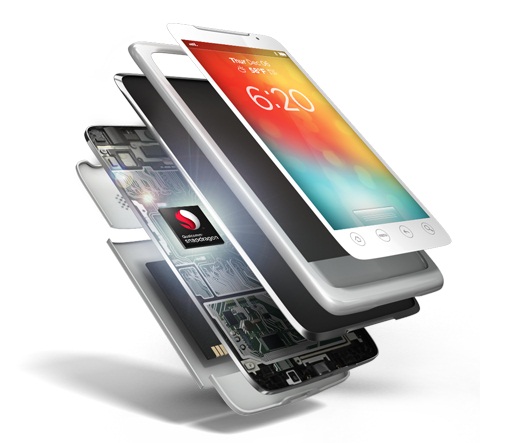New Qualcomm Snapdragon 850 Supports Ultra HD 4K Video

Qualcomm’s new chip promises video at Ultra HD 4K resolution, while the IPQ chipset targets the ‘Internet of Things’
Qualcomm has unveiled two new chipsets, the Snapdragon 850, which is capable of bringing 4K video to mobile devices, and another aimed at supporting the growing ‘Internet of Things’
The chip manufacturer has begun sampling the ARM-based quad-core Snapdragon 805, which includes an improved CPU design based on the company’s Krait architecture and is armed with its latest Adreno graphics processing unit.
The result is a much faster chip that will enable smartphones and tablets to run mobile video, imaging and graphics at Ultra HD 4K resolution, both on the device and when hooked up to Ultra HD television sets, according to the company.
Qualcomm Snapdragon 850
 “Using a smartphone or tablet powered by Snapdragon 805 processor is like having an UltraHD home theatre in your pocket, with 4K video, imaging and graphics, all built for mobile,” says Murthy Renduchintala, executive vice president of Qualcomm subsidiary Qualcomm Technologies and co-president of Qualcomm.
“Using a smartphone or tablet powered by Snapdragon 805 processor is like having an UltraHD home theatre in your pocket, with 4K video, imaging and graphics, all built for mobile,” says Murthy Renduchintala, executive vice president of Qualcomm subsidiary Qualcomm Technologies and co-president of Qualcomm.
The new chip features the Adreno 420 GPU, which company officials say offers up to 40 percent more graphics processing power than its predecessor and combines with other capabilities – including Ultra HD support, 4K video capture and playback, and improved dual-camera Image Signal Processors (ISPs) – to bring greater performance and power efficiency.
The CPU is based on the Krait architecture, and each of the four cores can run as fast as 2.5GHz. The chip also offers memory bandwidth support of up to 25.6G bps, which officials said will greatly improve multimedia and Web browsing capabilities. The Snapdragon 805 also integrates with Qualcomm’s Gobi MDM9x25 or MDM9x35 modem, which will offer greater connectivity than other Snapdragon chips, officials said.
The Gobi MDM9x25 chipset, introduced in February, supports 4G Long Term Evolution (LTE) aggregation with a peak data rate of up to 150Mbps. The Gobi 9×35 chipset was announced 20 November. With the two modems, Qualcomm is enabling mobile device users the capability of addressing the growing flavours of 4G LTE networks that are being built.
In addition, the Snapdragon 805 also will let users better leverage Wi-Fi networks, according to Qualcomm officials. The chip will integrate with Qualcomm’s two-stream dual-band VIVE 802.11ac, enabling smartphones and tablets to leverage mobile Wi-Fi that is faster than 600Mbps, as well as video streaming and concurrent Bluetooth connections, without harming battery life.
The Snapdragon 805 is sampling with manufacturers and will begin appearing on the market in mobile devices in the first half of 2014, company officials said.
In addition, another Qualcomm subsidiary, Qualcomm Atheros, unveiled the Qualcomm Internet Processor (IPQ), a chipset aimed at devices in the house that can connect to the Internet, including home gateways, routers and media servers. These devices can become platforms for what company officials are calling “Smarthomes.”
Internet Of Things
“Just as Qualcomm helped propel the smartphone experience and ecosystem, we are now employing the company’s mobile DNA to enable the Smarthome as a platform to deliver an advanced class of content, applications and services that can be enjoyed throughout the home,” explains Qualcomm Atheros President Amir Faintucht. “Qualcomm is bringing together its mobile and networking expertise in the Internet Processor to extend its portfolio and enable new capabilities for network platforms.”
The chipset not only will let device OEMs add such capabilities to their products in areas such as home automation and personal clouds, but also will enable service providers to offer even more content, applications and services – such as security and surveillance – to their customers, according to company officials.
Qualcomm bought Atheros in 2011 for $3.1 billion (£1.9bn) to extend its reach into home devices, networking and other areas. Qualcomm’s Smarthome platform includes a dual-core 1.4GHz Krait CPU and Qualcomm Atheros’ networking chip technologies – including the new dual-core 730 MHz Packet Processing Engine. The IPQ will enable more appliances in the home to be networked and connected to the Internet, which is the essence of the Internet of things.
Other chip makers also see opportunities in the Internet of things. Intel is building out a new line of low-power systems-on-a-chip (SoCs), called Quark, which will aim at such areas as the Internet of things and wearable devices. Advanced Micro Devices is rapidly growing out its embedded chip portfolio, and ARM officials see the Internet of things as a natural fit for their low-power processors. In March, ARM announced its energy-efficient Cortex-MO+ chip for the IoT. In August, the company bought Sensinode Oy, which made software for the IoT.
What do you know about the Internet of Things? Take our quiz!
Originally published on eWeek.